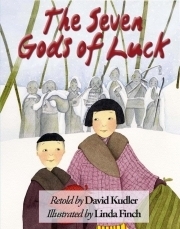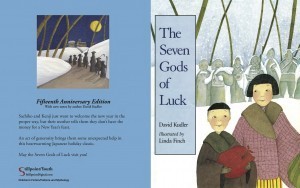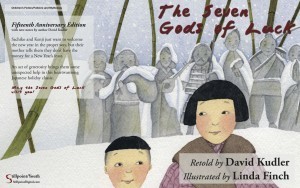David Kudler's Blog, page 24
November 4, 2012
Interested in more information about the Seven Gods of Luck?

Netsuke (carved ivory belt ties) of the Seven Gods of Luck (© 2012, David Kudler)
If you want to know more about the Seven Gods of Luck? Here’s a great page rom the online A to Z Photo Dictionary of Japanese Buddhist Statuary:
The Shichifukujin 七福神 are an eclectic group of deities from Japan, India, and China. Only one is native to Japan (Ebisu) and Japan’s indigenous Shintō tradition. Three are from the Hindu-Buddhist pantheon of India (Daikokuten, Bishamonten, & Benzaiten) and three from Chinese Taoist-Buddhist traditions (Hotei, Jurōjin, & Fukurokuju). In Japan, they travel together on their treasure ship (Takarabune) and visit human ports on New Year’s Eve to dispense happiness to believers. Each deity existed independently before Japan’s “artificial” creation of the group. The origin of the group is unclear, although most scholars point to the Muromachi Era (1392-1568) and the 15th century. Today, images of the seven appear with great frequency in Japan. By the 19th century, most major cities had developed special pilgrimage circuits for the seven. These pilgrimages remain well trodden today, but many people now use cars, buses, and trains to move between the sites.
>>READ MORE
Click the link to read more of an excellent discussion of the history and traditions related to the Shichi Fukujin, with lots of wonderful pictures!
(Note–the link leads to a commercial site that is not associated to Stillpoint Digital Press.)
November 1, 2012
Seven Gods of Luck Available Now!

The Seven Gods of Luck – Now Available!
Limited-Time Special Offer:
Print, Ebook and Audiobook for
Stillpoint Releases Classic Folktale
November 1, 2012 Stillpoint Digital Press announces the release of the fifteenth anniversary edition of the picturebook retelling of the classic Japanese folktale, The Seven Gods of Luck by David Kudler with illustrations by Linda Finch. Set during O-Shogatsu, the Japanese New Year festival, The Seven Gods of Luck is a magical holiday tale of generosity rewarded.
The beloved original edition has been updated with new author’s notes and additional information about O-Shogatsu and about the Seven Gods of Luck themselves. In addition, the book is now available as an ebook (ePub, Kindle, and PDF) and as an audiobook.
For a limited time only, all three formats are available from StillpointDigital.com for the exclusive price of the paperback edition alone. Visit http://stillpointdigital.com/seven-gods and take advantage of this offer while supplies last!

The Seven Gods of Luck
A Japanese Tale
Retold byDavid Kudler
Illustrated by Linda Finch
Picturebook: Kindergarten3rd Grade
Formats: Paperback, ebook (ePub 2/3, mobi/Kindle, PDF), audiobook (MP3)
Sachiko and Kenji just want to welcome the new year in the proper way, but their mother tells them they don’t have the money for a New Year’s feast.
An act of generosity brings help from an unexpected source in this heartwarming Japanese classic.
May the Seven Gods of Luck visit you!
“A lively adaptation of a Japanese folktale…. The well-paced, carefully plotted text has a sprightly partner in its stylized, gently colored illustrations.” – School Library Journal
>>BUY NOW!
Buy the paperback
and get the ebooks and audiobook
as our gift!
MORE STILLPOINT TITLES:





October 20, 2012
Thanks for helping us choose our cover!
Thanks to all of you who voted and who shared your wonderful insights regarding the cover for The Seven Gods of Luck! Here’s the final design (which has been uploaded to the printer–we’re waiting, again likely children before the holidays, for what we hope and trust are the final proofs):
Final Cover for The Seven Gods of Luck
Thanks to all of you who voted and who shared your wonder...
Thanks to all of you who voted and who shared your wonderful insights regarding the cover for The Seven Gods of Luck! Here’s the final design (which has been uploaded to the printer–we’re waiting, again likely children before the holidays, for what we hope and trust are the final proofs):

Final Cover for The Seven Gods of Luck
October 9, 2012
Seven Gods Cover Art – A Poll
I need your help!
So I’ve been working away to prepare The Seven Gods of Luck for simultaneous release as an ebook, a paperback, and an audiobook. Great fun! It’s almost ready…
Except for one thing — the cover.
I’ve been assuming that we’d be using a cover very similar to the one designed for the original edition:

This cover is based on the original Houghton Mifflin edition
However, Linda Finch, the artist and I, have been looking at a second option, which uses a type and color scheme that ties in with the interior design:

This cover is based on the new edition's layout
What do you think? Come to the Stillpoint Blog page and look in the right margin. The poll is there. Vote early! Vote often! Let use know what you think!
October 7, 2012
What can we do for you?
When it comes to words,
what can’t we?
Publishing (fiction, trade and academic non-fiction)
Design your book in print and/or ebook format
Print formats from simple black-and-white to complex, illustrated four-color
Ebook formats—Kindle (mobi/KF8) & ePub:
Fixed layout, flowing text, read-aloud, video- or audio-enhanced, etc.
Create a cover
Arrange printing—offset, short-run, or PoD
Manage distribution
Work with you to market your book
Editorial Services (books, papers, dissertations, programs, catalogs, fliers, websites, etc.)
Quick and accurate ebook conversion from print or digital original
Substantive and developmental editing
Co-writing
Copyediting and proofreading
Indexing
Image & quotes research and permissions
August 19, 2012
The Power — and the Study — of Myth

In the latter half of the 20th century, mythologist Joseph Campbell’s vast body of work — from “The Hero With A Thousand Faces” in 1949 to the broadcast of “Joseph Campbell and the Power of Myth with Bill Moyers” just months after his passing — resuscitated interest in comparative mythology, revitalizing the study of the field that Campbell called “the secret opening through which the inexhaustible energies of the cosmos pour into human cultural manifestation.”
However, that interest hasn’t necessarily translated into formal acceptance on college campuses. “Academia doesn’t seem to know what to do with mythology,” says Stephen Gerringer of the Joseph Campbell Foundation. Taught under the various umbrellas of history, anthropology, literature, philosophy, folklore, religion, psychology and other disciplines, mythology is rarely recognized as a separate field. To date, only one school — Pacifica Graduate Institute — offers a graduate program in Mythological Studies. As Gerringer points out, even Campbell taught mythology for decades at Sarah Lawrence as a member of the Literature Department.
With an eye to changing the status quo, Pacifica Graduate Institute, Joseph Campbell Foundation and OPUS Archives and Research Center (which houses the archives of Joseph Campbell, archaeologist Marija Gimbutas, psychologist James Hillman, and other scholars of note) are sponsoring the inaugural Symposium for the Study of Myth, over Labor Day Weekend (Aug. 31 – Sept. 2), on the Pacifica campus in Santa Barbara.
Entitled “Exploring Myth: Culture, Theory, Practice,” the conference aims to encourage serious scholarship, but that’s not its only purpose. Dr. Safron Rossi, who heads the OPUS Archives, pointed out, “Everyone with a passion and serious curiosity for myth is invited to participate in this fluid and dynamic event.”
Scholarship will of course play a role — but the symposium moves beyond traditional academic formats, with over 50 different presentations, from a demonstration of Chumash healing ceremonies or a discussion of video gaming as a storytelling medium, to workshops on percussion, rhythm and movement in myth, or a panel on teaching mythology in public schools.
Says Rossi, “We recognize that it is past time for the field of mythology to establish a “home” — a community to which it returns to discuss new developments in the area of study, as well as charting future domains of exploration. In creating this event, we hope to encourage the establishment of just such a home.” Students of mythology in attendance, both within and outside academia, will have the opportunity to participate in the birth of a collaborative community that takes an innovative, nontraditional approach to a nontraditional field.
“If all goes as planned,” says Gerringer, “Pacifica can soon look forward to competition from other colleges and universities offering advanced degrees in the field of mythology.”
Image by Henry Flower via commons.wikimedia.org; used under a Creative Commons license
August 6, 2012
Sail Away Signing a Huge Success
 Author Jack Beritzhoff reads from his newly published memoir
Sail Away: Journeys of a Merchant Seaman
Author Jack Beritzhoff reads from his newly published memoir
Sail Away: Journeys of a Merchant Seaman
August 5, Larkspur, CA. Jack Beritzhoff (93) didn’t start writing until he was ninety. Today, a packed house at Folio 949 listened to him read from his newly-published memoir, Sail Away: Journeys of a Merchant Seaman and then lined up to have the “young. aspiring author” (as he described himself) read from his book of memories about the time that he served as a member of the US Merchant Marine from early in World War II through the Korean War.
Sail Away follows Beritzhoff from port to port, around the globe to five continents. “Jack’s a born storyteller,” said David Kudler, publisher of Stillpoint Digital Press. “It was fun to work with him. He brings a world at war to life through a series of charming vignettes rather than sweeping tales of battle or flying shrapnel. Sail Away is a view of epic events seen through a very human-sized, very bright window, offering glimpses of humor, humanity, and grace at the darkest of times.”
 Jack Beritzhoff (Front) Signs His Memoir, Sail Away: Journeys of a Merchant Seaman. Back: John Beritzhoff, David Kudler (Publisher), Alex Beritzhoff, Lisa BeritzhoffOver a hundred people—family, friends, and supporter’s of the book’s recent Kickstarter campaign—crowded in to Folio to listen to Beritzhoff read, and to pick up an autographed copy of the book. “It was a wonderful event,” said David Kudler, publisher of Stillpoint Digital Press. “Getting to see four generations share in the release of a book like this, it makes working with Jack to get his story told all the more special. And Alex (Jack’s daughter, and owner of Folio) did a wonderful job setting up the event.”
Jack Beritzhoff (Front) Signs His Memoir, Sail Away: Journeys of a Merchant Seaman. Back: John Beritzhoff, David Kudler (Publisher), Alex Beritzhoff, Lisa BeritzhoffOver a hundred people—family, friends, and supporter’s of the book’s recent Kickstarter campaign—crowded in to Folio to listen to Beritzhoff read, and to pick up an autographed copy of the book. “It was a wonderful event,” said David Kudler, publisher of Stillpoint Digital Press. “Getting to see four generations share in the release of a book like this, it makes working with Jack to get his story told all the more special. And Alex (Jack’s daughter, and owner of Folio) did a wonderful job setting up the event.”
Beritzhoff seemed to to take his newfound celebrity in stride. “It’s nice, just once, pretending to be Noël Coward.”
Sail Away is being officially released on August 6, 2012. It is available in print and ebook editions through Amazon.com, Barnes and Noble, Apple’s iBookstore® and other on-line and local bookstores.
Stillpoint Digital Press (stillpointdigital.com) was launched in January, 2012 in Mill Valley, California as a publisher of fine digital and print books, from fiction to literary nonfiction, from memoir to poetry. It aims to provide digital publishing with a human face, offering a full range of editorial services, from editing, layout and ebook conversion to distribution and marketing.
According to Kudler, “Stillpoint/Memory (the imprint that published Sail Away) is one of our most exciting projects: a line of memoirs sharing the stories of people who may not be household names, but whose experiences will take your breath away. If, as Socrates said, ‘the unexamined life is not worth living,’ these are tales of lives that have not only be well worth the living, but well worth examining as well.” Jack Beritzhoff (left) and publisher David Kudler discuss the new release of Sail Away: Journeys of a Merchant Seaman
Jack Beritzhoff (left) and publisher David Kudler discuss the new release of Sail Away: Journeys of a Merchant Seaman
July 24, 2012
Stillpoint author Kate Moore talks Romance and the RITA® Awards
When Kate Moore heads south to Anaheim this weekend to attend the Romance Writers of America’s RITA® Awards, it will be for more than a chance to connect with her fans and fellow romance novelists. Her historical novel To Seduce an Angel is up for the Best Regency Historical Romance award.
David Kudler: This is your third time as a RITA finalist. Are you excited?
Kate Moore: Being a RITA finalist is a big thrill, because the other writers in the Regency category are so great, I am enjoying that “finalist” thrill while it lasts.
DK: What does To Seduce an Angel share with your previous two finalists?
KM: The short answer is “family.” Each is a story in which circumstances—a kidnapping, a marriage of convenience, and employment—force the hero/heroine into a relationship that dominates the plot. Once in that tight space they feel the pull of family dynamics on their relationship with each other. Relationships with brothers and sisters and parents influence how the characters come to understand each other and fall in love. Each of the RITA books is also a story in which the course of the Napoleonic wars affects the outcome.
DK: What do you think draws so many contemporary readers—and writers—to the Napoleonic, Regency era?
KM: It is the perfect cultural moment for setting a marriage-plot novel, in which the barrier to love provides all the tension and action. The Regency heroine has no “Plan B” if she fails to make a good match, so stakes are high. And all the elements that can divide a hero and heroine—birth, social standing, wealth, temperament, unspoken laws and customs—exist to be overcome.
The Regency fits the romance novel perfectly as a liberation plot as well. Laws, parents, and conventions of the time constrained women, but the Victorian era had not yet rendered them incapable of judging others and standing up for themselves. Consider the difference between an Elizabeth Bennet [from Austen’s Pride and Prejudice] and a Lucy Honeychurch [from E. M. Forester’s A Room with a View from a century later].
Ideas of masculinity similarly constrain the Regency hero, so that he, too, benefits from the mutual liberation accomplished by the plot.
DK: To Seduce an Angel takes advantage of those themes. Do you think that’s part of the book’s success?
KM: Readers loved Emma and Dav and wanted their happy ending in spite of the big barrier in the way. Emma and Dav are the youngest lovers I’ve written and the most damaged by the past, but both are admirable in a way we all can appreciate—in being loyal to those who depend on us even if that means sacrificing ourselves.
DK: On another topic—one of my favorites: Digital publishing. How do you think the ebook explosion is affecting romance publishing?
KM: Digital publishing’s impact on romance is huge and, of course, developing. For over thirty years RWA, publishers, and readers have interacted to develop the vast global market for romance. First the Internet and now e-readers are changing those familiar market dynamics for everyone. E-publishers are reshaping how books become known, how they are reviewed, and how they get into readers’ hands. Reader reviewers, readers, and writers of fan fiction have gained influence with the Internet, and writers who work with their readers have managed amazing sales feats from websites and social networking platforms.
Now with self-publishing, writers, who are willing to learn the ins and outs of the new model and who are willing to work to reach readers, can reap much larger rewards and reach a global audience in multiple languages and formats, something that only Harlequin could do before. The savvy, committed writer doesn’t turn the book over to a publishing house any longer; she manages its journey from her mind into the hands of readers.
One thing the e-reader changes is the impact of cover art in identifying the nature of particular book and the public presentation of the reading tastes of readers. Neither a Nook nor a Kindle is an embarrassment on the subway or the airplane.
DK: How do you see the genre changing? It seems to me—and I’m a bit slanted in my view, because I have teen daughters—that the recent popularity of novels that combine elements of fantasy/science fiction, adventure, and romance (such as the Twilight and Hunger Games books) is shifting all of those genres in new directions.
KM: I’ve just been reading about Zombie romance for young adult readers. In Warm Bodies, there’s a Zombie hero, and apparently it works [as does] I Kissed a Zombie and I liked It, a fun parody of the genre. Fifty Shades of Grey [which started life as Twilight fanfiction] continues a strong erotica trend that’s been gaining ground for years. Interestingly Grey is a perfect model of the new Internet empowered way of selling books. Grey came out of fan fiction and took advantage of the e-reader’s discreet format to get buzz going before publishers caught on and offered a print contract and film deal.
DK: What’s coming up for you? Your next novel, Blackstone’s Bride, is due out in just a few weeks. What do we have to look forward to?
KM: Blackstone’s Bride is like Jane Austen with spies. Each of the chapters begins with an observation from Pride and Prejudice. In the story a pair of impetuous lovers who once hurt each other terribly and separated must learn to see who each other truly is, not unlike Anne and Wentworth in Persuasion. In the meantime a scandalous painting, an unmistakable ring, a missing brother, a royal visit, and a deadly foreign agent get in the way.
Kate Moore is a scholar, a teacher, and the author of eleven romance novels, including her contemporary romance, Sexy Lexy . She will be signing her books at the RWA annual conference in Anaheim this weekend. For more about her and her work, visit KateMoore.com
The RITA Awards® is a registered trademark of the Romance Writers of America.
June 27, 2012
Writing the Inevitable but Unexpected
A novel never sleeps.
We’re on vacation. As my family plays, I’m working on yet another round of rewrites for a young-adult novel, trying to add a scene about half of the way through.
This has had me thinking quite a bit about the idea of justification—not as in left, right, and center, but as in setting up a scene properly so that a reader neither feels as if it came out of nowhere nor as if it was far too long in coming. Getting it just right is obviously every storyteller’s goal, and one of the more challenging aspects of storytelling. Aristotle said that the end of an effective plot must be “unexpected but inevitable.” I’d say, though, that the same can be true of any good scene, and it doesn’t take a whole lot to mess it up in one direction or the other.
The reason that I’ve had this on my mind, other than my on-going story addiction/obsession, is that the last two books I’ve emerged myself in were Victoria Roth’s Divergent and George R. R. Martin’s Game of Thrones.
Both of these are very, very fine books, as I know I’m not the first to tell you. But in each case, I have found myself feeling as if the author missed that justification sweet spot.
I first picked up Game of Thrones about six years back. I had driven a good family friend back to the train station from my late mother-in-law’s memorial service. While we waited for the train, he had given me a copy of the book, which I had heard wonderful things about but hadn’t had a chance to read. I started reading that evening and got as far as a scene about seventy pages in where—this almost certain isn’t worth warning as a spoiler, but…
Consider yourself warned.
###
A seven-year-old boy gets tossed out a window.
Was this scene justified by the plot? Yes. Did it move the story forward? Yes. Did I keep reading? No.
It wasn’t the right book for me at the time. I’d just lost a second family member in two years (and would lose two more in the next year and a half), and I had a seven-year-old of my own.
This year, however, I picked the book back up (actually, I’ve been listening to it on audio). I kept going past my earlier bail-out point, and have found that the writing is really, really good—original, compelling… But the idea driven home by that first death—no one is safe—gets re-sounded with such force—subtle force, but force nonetheless—that at the point that I’ve reached, about two-thirds of the way through the book, I get it: just about everyone that I have gotten attached to is going to have horrible, horrible things happen to them, and many of them are going to die.
This doesn’t make the book any less compelling, but it sure makes it a heck of a lot less enjoyable. I find myself wondering why I’m reading. I don’t need it to end with a heroic triumph, but I do feel as if I can see where everything is headed, and it’s none of it good. I find that picking up my headphones gets less and less appealing every time.
I remember having the same feeling reading 1984, though Orwell manages to make the main characters’ struggles uncertain enough, leaving just enough of a niggling hope that Winston Smith might actually find some kind of happy ending, unlikely as it seems, that in fact the ending is all the more effective.
Though Divergent is also a dystopic novel, it doesn’t suffer from the oppressive gloom that blankets Orwell’s masterpiece. Roth gets us deeply involved in the teen struggles of the heroine, Tris, as she joins a new faction in her fractured society, and as she undergoes initiation into a new way living and thinking. The book is a first-person-present rocket sled ride from the first few pages.
Then, about three-quarters of the way in, the plot takes an abrupt right-angle turn. (Since I’m discussing a later event in a more recent book, I am going to be a little more circumspect here and avoid giving too much away.) Much of the momentum that Roth had built up gets jettisoned as a new plot-thrust comes not out of nowhere, but out of the deep background, to sweep away whole characters and unresolved plot threads.
The turn of events isn’t entirely unjustified, but it did leave me—as well as a couple of the other readers that I’ve spoken with—feeling as if the book had been hijacked.
Does this make either of these books less compelling? Hardly. In each case, the characters are compelling and the situations deftly drawn. Martin’s fantasized medieval England and Roth’s post-Apocalypse Chicago are richly imagined.
But as I struggle to add this scene of my own, I can’t help but worry that I’m going to emulate these novels’ failures more than their many successes.



